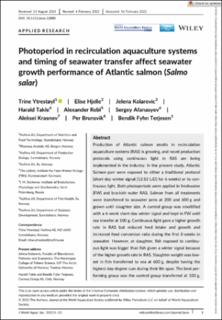| dc.contributor.author | Ytrestøyl, Trine | |
| dc.contributor.author | Hjelle, Elise | |
| dc.contributor.author | Kolarevic, Jelena | |
| dc.contributor.author | Takle, Harald Rune | |
| dc.contributor.author | Rebl, Alexander | |
| dc.contributor.author | Afanasyev, Sergey | |
| dc.contributor.author | Krasnov, Aleksei | |
| dc.contributor.author | Brunsvik, Per S. | |
| dc.contributor.author | Terjesen, Bendik Fyhn | |
| dc.date.accessioned | 2023-02-08T13:47:49Z | |
| dc.date.available | 2023-02-08T13:47:49Z | |
| dc.date.created | 2022-05-20T13:40:25Z | |
| dc.date.issued | 2022 | |
| dc.identifier.citation | Journal of the World Aquaculture Society. 2022, 1-23. | |
| dc.identifier.issn | 0893-8849 | |
| dc.identifier.uri | https://hdl.handle.net/11250/3049378 | |
| dc.description.abstract | Production of Atlantic salmon smolts in recirculation aquaculture systems (RAS) is growing, and novel production protocols using continuous light in RAS are being implemented in the industry. In the present study, Atlantic Salmon parr were exposed to either a traditional protocol (short-day winter signal [12:12 L:D] for 6 weeks) or to continuous light. Both photoperiods were applied in freshwater (FW) and brackish water RAS. Salmon from all treatments were transferred to seawater pens at 200 and 600 g and grown until slaughter size. A control group was smoltified with a 6-week short-day winter signal and kept in FW until sea transfer at 100 g. Continuous light gave a higher growth rate in RAS but reduced feed intake and growth and increased feed conversion ratio during the first 8 weeks in seawater. However, at slaughter, fish exposed to continuous light was bigger than fish given a winter signal because of the higher growth rate in RAS. Slaughter weight was lowest in fish transferred to sea at 600 g, despite having the highest day-degree sum during their life span. The best performing group was the control group transferred at 100 g. All treatments handled transfer to seawater and survival and maturation were not affected by the treatments in RAS. The immune status was examined with a multigene expression assay on BioMark HD platform from parr stage to 5–7 months after seawater transfer. Overall, there was no significant effect of photoperiod or salinity on the expression of the selected immune genes. In sum, the results from this study indicate that using continuous light in RAS may have negative effects on performance shortly after transfer in fish transferred to sea at 200 g, whereas at 600 g, all treatments had reduced growth after transfer irrespective of treatment in RAS. | |
| dc.language.iso | eng | |
| dc.title | Photoperiod in recirculation aquaculture systems and timing of seawater transfer affect seawater growth performance of Atlantic salmon (Salmo salar) | |
| dc.title.alternative | Photoperiod in recirculation aquaculture systems and timing of seawater transfer affect seawater growth performance of Atlantic salmon (Salmo salar) | |
| dc.type | Peer reviewed | |
| dc.type | Journal article | |
| dc.description.version | publishedVersion | |
| dc.source.pagenumber | 1-23 | |
| dc.source.journal | Journal of the World Aquaculture Society | |
| dc.identifier.doi | 10.1111/jwas.12880 | |
| dc.identifier.cristin | 2025989 | |
| dc.relation.project | Norges forskningsråd: 237856 | |
| dc.relation.project | Norges forskningsråd: 267644 | |
| dc.relation.project | Fiskeri- og havbruksnæringens forskningsfinansiering: 901293 | |
| cristin.ispublished | true | |
| cristin.fulltext | original | |
| cristin.qualitycode | 1 | |
